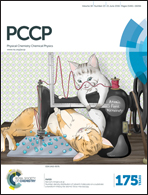Mechanisms and energetics for N-glycosidic bond cleavage of protonated adenine nucleosides: N3 protonation induces base rotation and enhances N-glycosidic bond stability†
Abstract
Our previous gas-phase infrared multiple photon dissociation action spectroscopy study of protonated 2′-deoxyadenosine and adenosine, [dAdo+H]+ and [Ado+H]+, found that both N3 and N1 protonated conformers are populated with the N3 protonated ground-state conformers predominant in the experiments. Therefore, N-glycosidic bond dissociation mechanisms of N3 and N1 protonated [dAdo+H]+ and [Ado+H]+ and the associated quantitative thermochemical values are investigated here using both experimental and theoretical approaches. Threshold collision-induced dissociation (TCID) of [dAdo+H]+ and [Ado+H]+ with Xe is studied using guided ion beam tandem mass spectrometry techniques. For both systems, N-glycosidic bond cleavage reactions are observed as the major dissociation pathways resulting in production of protonated adenine or elimination of neutral adenine. Electronic structure calculations are performed at the B3LYP/6-311+G(d,p) level of theory to probe the potential energy surfaces (PESs) for N-glycosidic bond cleavage of [dAdo+H]+ and [Ado+H]+. Relative energetics of the reactants, transition states, intermediates and products along the PESs for N-glycosidic bond cleavage are determined at the B3LYP/6-311+G(2d,2p), B3LYP-GD3BJ/6-311+G(2d,2p), and MP2(full)/6-311+G(2d,2p) levels of theory. The predicted N-glycosidic bond dissociation mechanisms for the N3 and N1 protonated species differ. Base rotation of the adenine residue enables formation of a strong N3H+⋯O5′ hydrogen-bonding interaction that stabilizes the N3 protonated species and its glycosidic bond. Comparison between experiment and theory indicates that the N3 protonated species determine the threshold energies, as excellent agreement between the measured and B3LYP computed activation energies (AEs) and reaction enthalpies (ΔHrxns) for N-glycosidic bond cleavage of the N3 protonated species is found.


 Please wait while we load your content...
Please wait while we load your content...